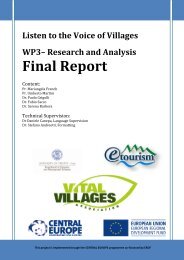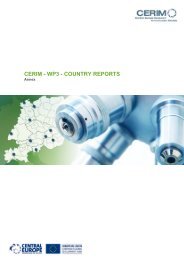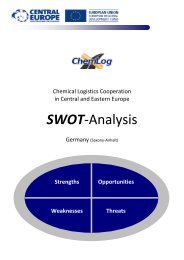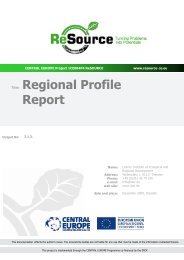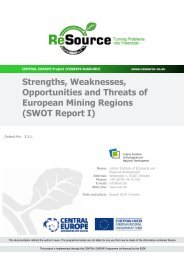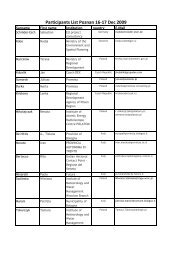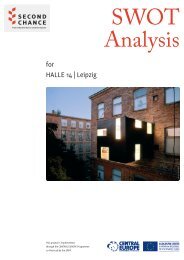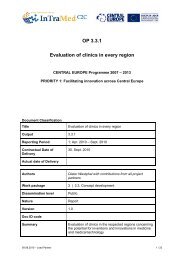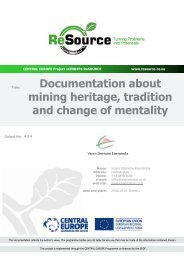Mainly on the Elbe River - Central Europe
Mainly on the Elbe River - Central Europe
Mainly on the Elbe River - Central Europe
Create successful ePaper yourself
Turn your PDF publications into a flip-book with our unique Google optimized e-Paper software.
2 ANALYSIS OF THE CURRENT STATE<br />
2.1 GENERAL SITUATION<br />
Inland waterway transport is an important transport mode, which allows improving and ensuring<br />
sustainable <strong>Europe</strong>an transportati<strong>on</strong> system. Due to growing volumes of transported commodities,<br />
<strong>the</strong> land traffic routes (roads, railways) are facing increased c<strong>on</strong>gesti<strong>on</strong>s associated with time<br />
losses and resulting in envir<strong>on</strong>mental issues. There are 35.000 km of inland waterways in <strong>the</strong><br />
<strong>Europe</strong>an Uni<strong>on</strong> and <strong>the</strong> network is densest in Western <strong>Europe</strong>.<br />
Thanks to <strong>the</strong> possibility to transport oversized items, to <strong>the</strong> high safety level (<strong>the</strong> lowest<br />
accident rate), to low transport costs and to envir<strong>on</strong>mental friendly operati<strong>on</strong>, <strong>the</strong> river transport is<br />
a str<strong>on</strong>g competitor to road and railway transport. In additi<strong>on</strong>, inland water transport offers <strong>the</strong><br />
possibility to serve as a valuable part of <strong>the</strong> combined transportati<strong>on</strong> and <strong>the</strong> logistic chain. The<br />
main commodities currently transported by inland waterways are mainly bulk materials, animal<br />
feeds, fertilizers, grain, ore and scrap metal, solid and liquid fuels and c<strong>on</strong>tainer transportati<strong>on</strong> is<br />
<strong>on</strong> <strong>the</strong> rise as well.<br />
The foreseen trend for <strong>the</strong> inland waterway transport shows c<strong>on</strong>stant growth. According to <strong>the</strong><br />
study TEN-STAC, increase in transported volumes will be by 2,5 % in nati<strong>on</strong>al and 3,4 % in<br />
internati<strong>on</strong>al transport until <strong>the</strong> year 2020. The report <strong>on</strong> <strong>Europe</strong>an waterway transport 2002<br />
predicts rise in performance (t<strong>on</strong>s-km) by 2 % per year until 2015.<br />
2.2 THE ELBE WATERWAY<br />
The <strong>Elbe</strong> is <strong>on</strong>e of <strong>the</strong> largest rivers in <strong>Europe</strong>. It rises in <strong>the</strong> Czech Republic, flows through<br />
Germany and empties into <strong>the</strong> North Sea. The total length of <strong>the</strong> <strong>Elbe</strong> river route is 1.154 km with a<br />
river-basin area of 144.055 km 2 . The <strong>Elbe</strong> waterway offers great potential for transportati<strong>on</strong> under<br />
<strong>the</strong> c<strong>on</strong>diti<strong>on</strong> of <strong>the</strong> whole year ec<strong>on</strong>omical operati<strong>on</strong> of cruises. The <strong>Elbe</strong> waterway is a part of <strong>the</strong><br />
IV. Trans-<strong>Europe</strong>an multimodal corridor and is marked as waterway E20 by <strong>the</strong> AGN agreement<br />
(<strong>Europe</strong>an Agreement <strong>on</strong> Main Inland Waterways of Internati<strong>on</strong>al Importance), which defines <strong>the</strong><br />
<strong>Europe</strong>an waterway network of internati<strong>on</strong>al importance and <strong>the</strong> commitment to abide by given<br />
parameters in <strong>the</strong> development of waterways. The AGN Agreement was approved in Geneva <strong>on</strong><br />
19 th January 1996, became effective by its article 8, paragraph 2, <strong>on</strong> 26 th July 1999. The AGN<br />
Agreement provides following characteristics and criteria of waterways and of internati<strong>on</strong>al ports:<br />
Technical characteristics of waterways within <strong>the</strong> category E:<br />
Evaluati<strong>on</strong> of individual waterways distinguishes categories IV – VII with various characteristics<br />
according to <strong>the</strong> following principles:<br />
A feasibility study for “Improvement of C<strong>on</strong>diti<strong>on</strong>s for <strong>the</strong> <strong>River</strong> Transport in <strong>Central</strong> <strong>Europe</strong> (mainly <strong>on</strong> <strong>the</strong> <strong>Elbe</strong><br />
<strong>River</strong>)“ realized within <strong>the</strong> ChemLog project 9




